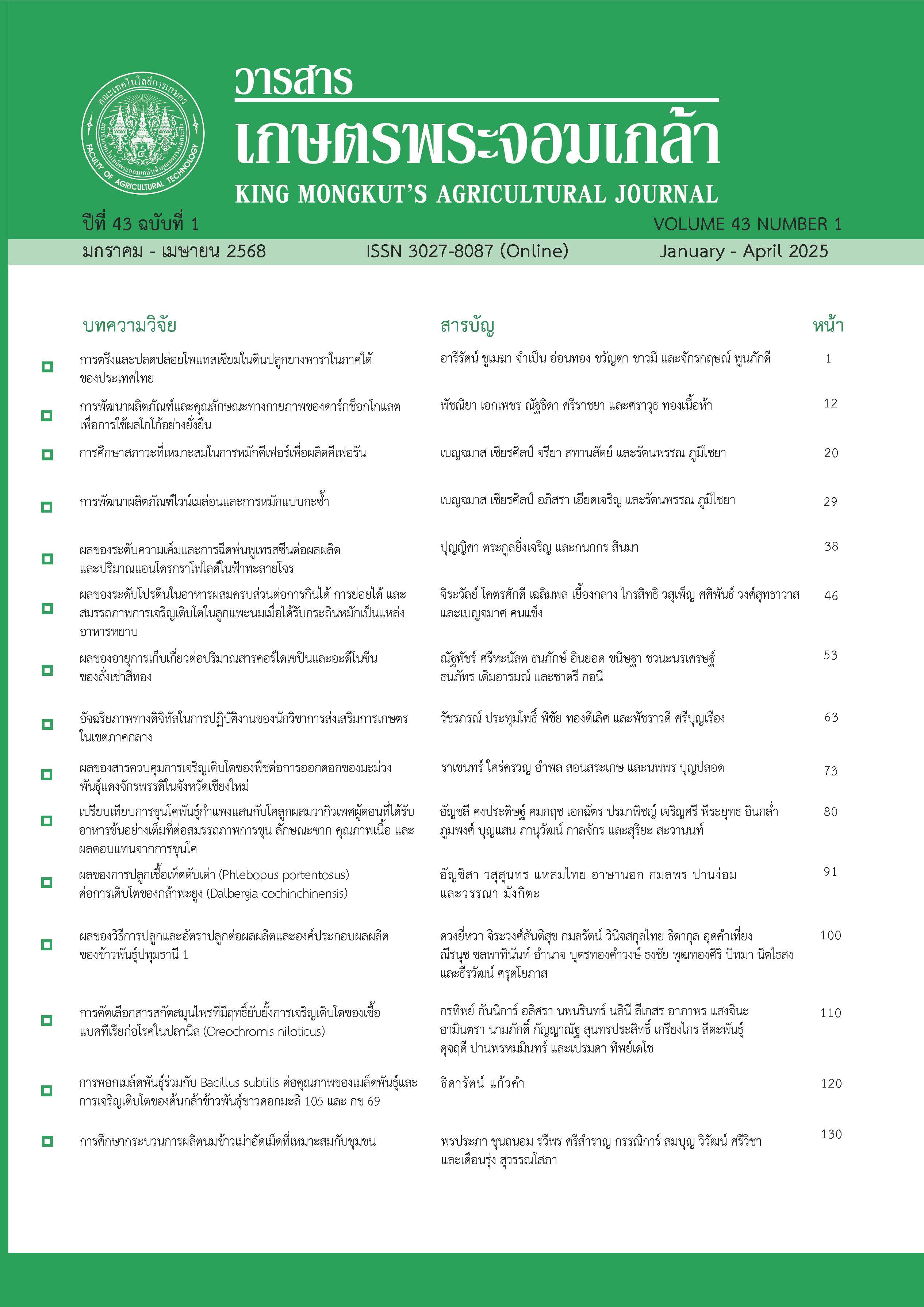ผลของอายุการเก็บเกี่ยวต่อปริมาณสารคอร์ไดเซปินและอะดีโนซีนของถั่งเช่าสีทอง
Main Article Content
บทคัดย่อ
การศึกษานี้มีวัตถุประสงค์เพื่อตรวจสอบอายุการเก็บเกี่ยวถั่งเช่าสีทองและเปรียบเทียบสูตรอาหารที่มีผลต่อปริมาณสารคอร์ไดเซปินและอะดีโนซีน แบ่งชุดการทดลองตามสูตรอาหาร 3 สูตร ได้แก่ ข้าวสังข์หยดผสมน้ำเปล่า (สูตรที่ 1) ข้าวสังข์หยดผสมน้ำต้มมันฝรั่ง (สูตรที่ 2) และข้าวสังข์หยดผสมดักแด้ปั่น (สูตรที่ 3) ร่วมกับระยะเวลาการเก็บเกี่ยวที่ 60, 70, 80 และ 90 วัน วางแผนการทดลองสุ่มสมบูรณ์ในบล็อก (Randomized Complete Block Design, RCBD) จำนวน 4 ซ้ำๆ ละ 10 ขวด ผลการศึกษา พบว่าผลผลิต ปริมาณสารสารคอร์ไดเซปินและสารอะดีโนซีนมีความแตกต่างอย่างมีนัยสำคัญทางสถิติ (P≤0.05) โดยอาหารสูตร 3 อายุการเก็บเกี่ยว 80 วัน ให้น้ำหนักสดและน้ำหนักแห้งเฉลี่ยสูงสุด 66.97±1.80 และ 7.68±0.58 กรัมต่อขวด ตามลำดับ อีกทั้งยังให้ผลผลิตร้อยละเฉลี่ยสูงสุด 14.40±0.82 เปอร์เซ็นต์ เมื่อนำไปวิเคราะห์หาปริมาณสารคอร์ไดเซปินและสารอะดีโนซีนในถั่งเช่า สีทองด้วยเทคนิค High Performance Liquid Chromatography (HPLC) พบว่าอาหารสูตร 3 ที่อายุการเก็บเกี่ยว 80 วัน มีปริมาณสารคอร์ไดเซปินเฉลี่ยสูงสุด 1,506.80±18.12 มิลลิกรัม /100 กรัม ในขณะที่สูตร 2 ที่อายุการเก็บเกี่ยว 60 วัน มีปริมาณสารอะดีโนซีนเฉลี่ยสูงสุดเท่ากับ 118.70±0.82 มิลลิกรัม /100 กรัม การศึกษานี้แสดงให้เห็นว่าช่วงเวลาที่เหมาะสมกับการเก็บเกี่ยวถั่งเช่าสีทองคือ ที่อายุ 80 วัน ส่วนสูตรอาหารที่ให้สารคอร์ไดเซปินสูงที่สุดคือ สูตรข้าวสังข์หยดผสมกับดักแด้ปั่น และสูตรอาหารที่ให้สารอะดีโนซีนที่สูงคือ สูตรข้าวสังข์หยดผสมกับน้ำต้มมันฝรั่ง
Article Details

This work is licensed under a Creative Commons Attribution-NonCommercial-NoDerivatives 4.0 International License.
วารสารเกษตรพระจอมเกล้า
References
Aramwit, P., Bang, N., Ratanavaraporn, J., Nakpheng, T., & Teerapol, S. (2014). An anti-cancer cordycepin produced by Cordyceps militaris growing on the dead larva of Bombyx mori silkworm. Journal of Agricultural Science, 6(6), 41-53. (in Thai).
Buenz, E. J., Bauer, B. A., Osmundson, T. W., & Motley, T. J. (2005).The traditional chinese medicine Cordyceps sinensis and its effects on apoptotic homeostasis. Journal of Ethnopharmacology, 96(1-2), 19-29.
Chen, X. M., Lu, J. X., Zhang, Y. D., He, J. T., Guo, X. Z., Tian, G. Y., & Jin, L. Q. (2008). Studies of macrophage immuno-modulating activity of polysaccharides isolated from Paecilomyces tenuipes. International Journal of Biological Macromolecules, 43(3), 252-256.
Choi, S., Lim, M. H., Kim, K. M., Jeon, B. H., Song, W. O., & Kim T. W. (2011). Cordycepin induced apoptosis and autophagy in breast cancer cells are independent of the estrogen receptor. Toxicology and Applied Pharmacology, 257(2), 165-168.
Chioza, A., & Ohga, S. (2013). Mycelial growth of paecilomyces hepiali in various agar media and yield of fruit bodies in rice based media. Advances in Microbiology, 3(1), 529-536.
Du, L., Song, J., Wang, H., Li, P., Yang, Z., Meng, L., & Teng, L. (2012). Optimization of the fermentation medium for Paecilomyces tenuipes N45 using statistical approach. African Journal of Microbiology Research, 6(32), 6130-6141.
Das, S. K., Masuda, M., Sakurai, A., & Sakakibar, M. (2010). Medicinal use of the mushroom Cordyceps militaris: Current state and prospects. Filtoterapia, 81(8), 961-968.
Hong, I. P., Kang, P. D., Kim, K. Y., Nam, S. H., Lee, M. Y., Choi, Y. S., Kim, N. S., Kim, H. K., Lee, K. G. & Humber, R. A. (2010). Fruit body formation on silkworm by Cordyceps militaris. Mycobiology, 38(2), 128-132.
Holliday, J., & Cleaver, M. (2008). Medicinal value of caterpillar fungi species of the genus Cordyceps (Fr.) Link (Ascomycates). International Journal of Medicinal Mushrooms, 10(3), 219-234.
Hsieh, C., Tsai, M., Hsu, T., Chang, D., & Lo, C. (2005) Medium optimization for polysaccharide production of Cordyceps sinensis. Applied Biochemistry and Biotechnology, 120(2), 145-157.
Huang, L., Li, Q., Chen, Y., Wang, X., & Zhou, X. (2009). Determination and analysis of cordycepin and adenosine in the products of Cordyceps spp. African Journal of Microbiology Research, 3(12), 957-961.
Itharat, A., Uttama, S., & Makchuchit, S. (2016). Anti-inflammatory activities of constituents in sang yod rice extracts, γ-oryzanol, vitamins E, B1, B2 and B3, using inhibitory effects on nitric oxide (NO) production in lipopolysaccharide (LPS) activated RAW 264.7 murine macrophage cells. Medicinal and Aromatic Plants, 5(3), 1-6.
Khumsaensr, S., Kulsarin, J., Tapingkae, T., Buranapanichpan, S., & Kumpiro, S. (2019). Effects of edible insects as ingredient in sabouraud dextrose broth and culture media on growth of gold Cordyceps, Cordyceps militaris (L.) Link. Journal of Agriculture, 35(3), 365-374. (in Thai).
Kim, H. O., & Yun, J. W. (2005). A comparative study on the production of exopolysaccharides between two entomopathogenic fungi Cordyceps militaris and Cordyceps sinensis in submerged mycelial cultures. Journal of Applied Microbiology, 99(4), 728-738.
Lan, Y. W., Kit, C. D., Lan, M. J., & Zhao, S. P. (2015). Fermentation optimization for the production of bioactive polysaccharides from Cordyceps sinensis fungus UM01. International Journal of Biological Macromolecules, 79(1), 180-185.
Liang, Z. C., Liang, C. H., & Wu, C. Y. (2014). Various grain substrates for the production of fruiting bodies and bioactive compounds of the medicinal caterpillar mushroom, Cordyceps militaris (Ascomycetes). International Journal of Medical Sciences Mushrooms, 16(6), 569-578.
Mu, X., Fa, J. C., Shuai, C., Yu, L. C., Xing, L., Jiao, L., Xue, H., & Hong, L. X. (2010). Effects of Light Hours on Growth and Development of Cordyceps militaris. Journal of Hebei Agricultural Sciences, 14(12), 160-170.
Oh, J., Yoon, D., Shrestha, B., Choi, H., & Sung, G. (2019). Metabolomic profiling reveals enrichment of cordycepin in senescence process of Cordyceps militaris fruit bodies. Journal of Microbiology, 57(1), 54–63.
Sornprasert, R., Hambananda, A., & Aroonsrimorakot, S. (2016). Cultivation of Cordyceps militaris Using Differrent Cereal Geains and Local Insects and Inhibitory Efficiency Against Trichophyton rubrum and Staphylococcus aureus. The Journal of King Mongkut's University of Technology North Bangkok, 26(2), 239-251. (in Thai).
Tapingka, T. (2012). Cordyceps mushroom cultivation. Kehakaset, 36(4), 113-117.
Tongaram, Y. (2015). A comparative study of Cordypeps militalis (Tung Chao) culture from liquid and solid inoculation on growth medium mixed with thai millet. CRMA Journal, 13(1), 87-99. (in Thai).
Wang, J., Kan, L., Nie, S., Chen, H., Cui, S. W., & Phillips, A. O. (2015). A comparison of chemical composition, bioactive components and antioxidant activity of natural and cultured Cordyceps sinensis. Food Science and Technology, 63(1), 2-7.
Waraporn, S. (2013). Development of culture media inducing stroma production of Cordyceps sp. Khon Kaen Agriculture Journal, 20(Suppl 1), 492-497. (in Thai).
Winkler, D. (2008). Yartsa gunbu (Cordycepe sinensis) and the fungal commodification of Tibet’s rural economy. Journal of Economic and Taxonomic Botany, 6(1), 291-305.
Xiao, J. H., & Zhong, J. J. (2007). Secondary metabolites from Cordyceps species and their antitumor activity studies. Recent Patents on Biotechnology, 1(2), 123-137.
Yoshikawa, N., Nakamura, K., Yamaguchi, Y., Kagota, S., Shinozuka, K., & Kunitoma, M. (2007). Cordycepin and Cordyceps sinensis reduce the growth of human promyelocytic leukaemia cells through the Wnt signalling pathway. Clinical and Experimental Pharmacology and Physiology, 34(1), 61-63.
Zhou, X., Gong, Z., Su, Y., Lin, J., & Tang, K. (2009). Cordyceps fungi: Natural products, pharmacological functions and developmental products. Journal of Pharmacy and Pharmacology, 61(3), 279-291.

